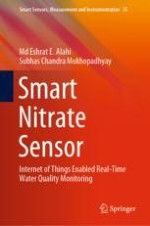This book presents the design and development of an Internet of Things (IoT) enabled, smart sensor to detect nitrate contamination in natural water. It considers three different sensors designed, fabricated and configured for nitrate detection: a Graphite/PDMS and Si-based MEMS sensors, and aFR4-based sensor. It also introduces a selective polymer material developed by means of the ion imprinting polymerization technique that was used as a coating on the Si-based MEMS sensor. Further, the book discusses the development of a smart sensing system that can be used to remotely monitor the nitrate concentration in any water. Fully explaining all the techniques used, the book is of interest to engineers, researchers and scientists working in the field of the water-quality measurement.
